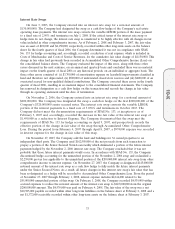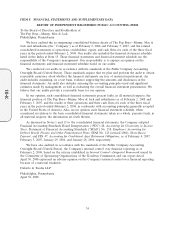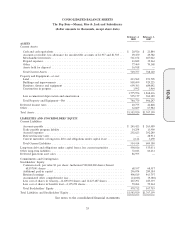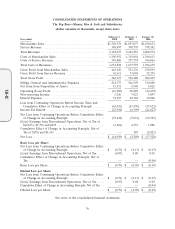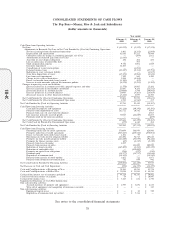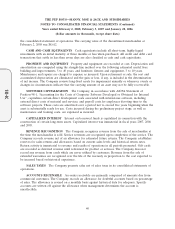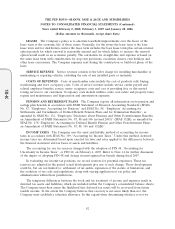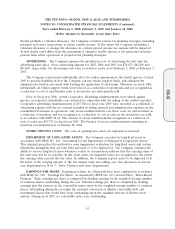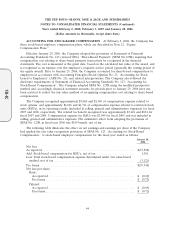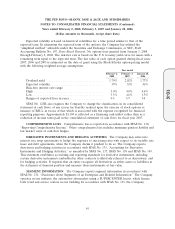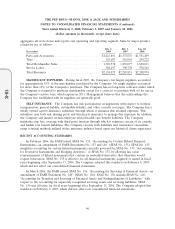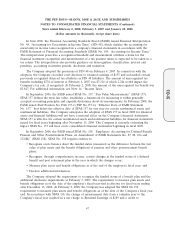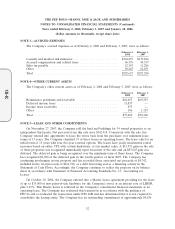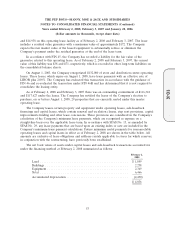Pep Boys 2007 Annual Report Download - page 89
Download and view the complete annual report
Please find page 89 of the 2007 Pep Boys annual report below. You can navigate through the pages in the report by either clicking on the pages listed below, or by using the keyword search tool below to find specific information within the annual report.
THE PEP BOYS—MANNY, MOE & JACK AND SUBSIDIARIES
NOTES TO CONSOLIDATED FINANCIAL STATEMENTS (Continued)
Years ended February 2, 2008, February 3, 2007 and January 28, 2006
(dollar amounts in thousands, except share data)
should establish a valuation allowance, the Company considers various tax planning strategies, including
potential real estate transactions, as future taxable income. To the extent the Company establishes a
valuation allowance or change the allowance in a future period, income tax expense will be impacted.
Actual results could differ from this assessment if adequate taxable income is not generated in future
periods from either operations or projected tax planning strategies.
ADVERTISING The Company expenses the production costs of advertising the first time the
advertising takes place. Gross advertising expense for 2007, 2006 and 2005 was $78,475; $84,206 and
$85,809, respectively. No advertising costs were recorded as assets as of February 2, 2008 or February 3,
2007.
The Company restructured substantially all of its vendor agreements in the fourth quarter of fiscal
2005 to provide flexibility in how the Company can use vendor support funds, and eliminate the
administrative burden associated with tracking the application of such funds. Therefore, in fiscal 2006,
substantially all vendor support funds were treated as a reduction of inventories and are recognized as
a reduction to cost of merchandise sales as inventories are subsequently sold.
Prior to fiscal year 2006, certain cooperative advertising reimbursements were netted against
specific, incremental, identifiable costs incurred in connection with the selling of the vendor’s product.
Cooperative advertising reimbursements of $35,702 for fiscal year 2005 were recorded as a reduction of
advertising expense with the net amount included in selling, general and administrative expenses in the
consolidated statement of operations. Any excess reimbursements over these costs are characterized as
a reduction of inventory and are recognized as a reduction of cost of sales as the inventories are sold,
in accordance with EITF 02-16. The amount of excess reimbursements recognized as a reduction of
costs of sales was $53,753 for fiscal year 2005. The balance of excess reimbursements remaining in
inventory was immaterial as of January 28, 2006.
STORE OPENING COSTS The costs of opening new stores are expensed as incurred.
IMPAIRMENT OF LONG-LIVED ASSETS The Company accounts for long-lived assets in
accordance with SFAS No. 144, ‘‘Accounting for the Impairment or Disposal of Long-Lived Assets.’’
This standard prescribes the method for asset impairment evaluation for long-lived assets and certain
identifiable intangibles that are both held and used or to be disposed of. The Company evaluates the
ability to recover long-lived assets whenever events or circumstances indicate that the carrying value of
the asset may not be recoverable. In the event assets are impaired, losses are recognized to the extent
the carrying value exceeds the fair value. In addition, the Company reports assets to be disposed of at
the lower of the carrying amount or the fair market value less selling costs. See discussion of current
year impairments in Note 7, ‘‘Store Closures and Asset Impairments.’’
EARNINGS PER SHARE Earnings per share for all periods have been computed in accordance
with SFAS No. 128, ‘‘Earnings Per Share’’ as amended by SFAS No. 123 (revised 2004), ‘‘Share-Based
Payment.’’ Basic earnings per share is computed by dividing earnings by the weighted average number
of common shares outstanding during the year. Diluted earnings per share is computed by dividing
earnings plus the interest on the convertible senior notes by the weighted average number of common
shares outstanding during the year plus the assumed conversion of dilutive convertible debt and
incremental shares that would have been outstanding upon the assumed exercise of dilutive stock
options. During fiscal 2007, no convertible notes were outstanding.
43
10-K


